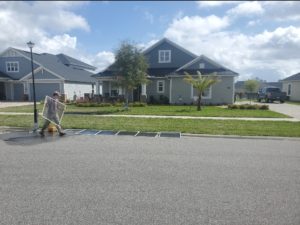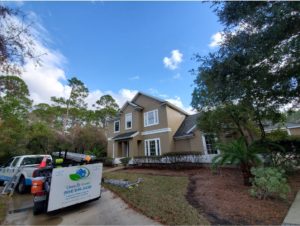Power Washing Vs Pressure Washing: Making the Best Choice for Your Property
When it comes to cleaning outdoor surfaces like driveways, sidewalks, and decks, many homeowners are unsure of which type of washing method to use: power washing or pressure washing. It’s important to choose the right kind of wash for your particular needs in order to get the best results. Here is a quick power washing vs pressure washing comparison to help you make the best choice between for your property.
What is power washing and pressure washing
Power washing and pressure washing both refer to the practice of cleaning exterior surfaces with pressurized streams of water. The primary distinction between the two is that power washing utilizes hot water, while pressure washing uses cold water. Power washing can be effective on dirt, grease, grime and mold, while pressure washing is better-suited for gentle cleaning of most surfaces, making it great for preparing wood or concrete surfaces prior to staining or painting. Both provide an efficient way to clean vast areas quickly with minimal effort and are often used in roof cleaning and other restoration tasks as well.

The benefits of each method
Pressure and power washing are two essential services used on a broad range of surfaces. Pressure washing utilizes a high-pressure stream of water to quickly remove dirt, mildew, grime, mold, and other buildup. This method is often referred to as “jetting” and works best on hard non-porous surfaces like concrete and stone. Power washing uses hot water along with detergents which allows it to effectively deep clean soft materials like wood decking or siding in addition to hard non-porous surfaces. Both pressure and power washing offer several key benefits that can help keep homes and other properties looking their best. Pressure washing is fast, efficient, budget friendly, and aesthetically pleasing due to the strong water jet that removes the dirt without damaging the surface underneath. Whereas power washing is ideal for soft surfaces like wood decking or siding due to its thorough cleaning action that leaves these materials looking as good as new.
When it is best to use power washing vs pressure washing
When deciding between power washing and pressure washing to clean a surface, it’s important to first consider the material that is being cleaned. Power washing uses heated water to remove tougher elements from surfaces, like grease or mud, and it can also be used for more powerful cleaning on material such as stone and concrete. Conversely, pressure washing is a less intense method of cleaning and is suitable for materials like wood siding trellises, which may be harmed by too much heat. Knowing when to use power washing vs pressure washing can enhance your overall results while deterring potential damage- making careful consideration an important step when deciding which cleaning method best suits your needs.
Tips on how to get the most out of each method
When it comes to power washing and pressure washing, it is important to understand the strengths and weaknesses of each method in order to maximize their effectiveness. Pressure washing is great for removing dirt, dust, and grime from the surfaces of residential and commercial buildings. Power washing, on the other hand, uses heated water, and can be used on organic matter such as mold or lichen; it should be avoided for use on fragile surfaces. As a rule of thumb, power washing is more effective at deep-cleaning tougher materials, while pressure washing will clean surfaces more quickly but may require multiple passes. In general, both power washing and pressure washing can be very effective tools when used properly.
Summarizing the pros and cons of each method
Power washing and pressure washing are two popular techniques used to clean a variety of surfaces. Power washing mainly involves the use of higher water pressure, making it better suited for tougher tasks such as removing dirt and grime from brickwork or concrete. Pressure washing, on the other hand, is more gentle and ideal for cleaning surfaces which could be damaged by higher pressure. It can also quickly break down mud and mold without completely destroying the surface in question. While power washing offers deeper cleaning, pressure washing is more time-efficient, cost-effective and less likely to cause damage. Ultimately, both methods offer different advantages that are worth considering before undertaking any exterior home maintenance projects.
Whatever project you choose to tackle with power or pressure washing, understanding the benefits and drawbacks of each method can help ensure you make the right choice for your specific needs.

https://www.google.com/maps?cid=664192561973241055
















